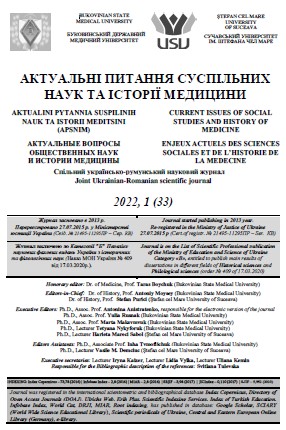ВИТОКИ НОВІТНЬОЇ СТРУКТУРИ ТА ІНСТИТУЦІОНАЛІЗАЦІЇ ДЕРЖАВНОЇ ПОЛІТИКИ ЩОДО ВЕТЕРАНІВ У США
ORIGINS OF MODERN STRUCTURE AND INSTITUTIONALIZATION OF THE US PUBLIC POLICY ON VETERANS
Author(s): Maria BAZAIEVASubject(s): Military history, Military policy, Welfare systems, 18th Century, 19th Century, Pre-WW I & WW I (1900 -1919), WW II and following years (1940 - 1949), Socio-Economic Research
Published by: Видавництво ВДНЗ України « Буковинський державний медичний університет »
Keywords: veteran; policy on veterans; American Revolutionary War; American Civil War; First World War; Second World War;
Summary/Abstract: The article explores the incipience process and evolution of the US public policy on veterans. Modern US veterans' policy is a sample for other countries, particularly Ukraine. The study aims to characterize historical periods in relations between the state, society, and veterans and analyze core incentives, sources, and the grounds for developing veterans' policy in the US. The research methods include criticism of historical sources, descriptive methods, comparative analysis, and the prosopography approach. Conclusions. The United States has a long tradition of forming state policies on veterans. Historical periods in this process could be associated with the major wars in US history: American Revolutionary War, Civil War, and two World Wars. During this time, the authorities have been looking for practical solutions to veterans' problems. Early veterans' programs included medical care, especially for disabled veterans, and pensions. The other component of veterans policy, commemoration, arose at the federal level after the American Revolutionary War and developed after the Civil War. In the 20th century, the institutionalization of public policy on veterans began. Following the First World War, new veterans' benefits were established, including special insurance for military personnel, pensions, compensations for disabled veterans, and vocational rehabilitation programs. During the decade after the war, the Veterans Bureau was established, which in 1930 transformed into the Veterans Administration. These institutions consolidated all veterans' benefits programs. In 1923 the history of the American Battle Monuments Commission, the institution responsible for commemoration after both world wars, began. The next stage in veterans' policy forming is the diversification of benefits for demobilized military personnel after the Second World War. The most significant law of the period is the Servicemen's Readjustment Act of 1944 (the G. I. Bill of Rights). The law can be considered a watershed in the history of veterans' policies. It formed a modern structure of veterans' benefits as a complex veteran-centered program aimed to integrate former military personnel into civilian life. According to the G. I. Bill of Rights, a new benefits program was founded.
Journal: Актуальні питання суспільних наук та історії медицини
- Issue Year: 2022
- Issue No: 1
- Page Range: 15-21
- Page Count: 7
- Language: Ukrainian

